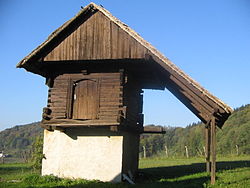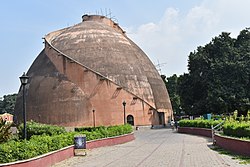Granary

A granary is a building or room (usually in a barn) that holds grain. It keeps the grain dry so it does not spoil, and keeps it away from animals that would eat it. They are an important part of a farm. If the grain is lost, eaten by pests, or ruined, the farmers might starve or lose much money.
History
Granaries have been around as long as humans have had agriculture and in some cases even before we planted crops. The earliest ones are over 11,000 years old and stored grains that grew in the wild and were collected by hand.[1]
Structure
Granaries usually have few, if any, windows. They are often built off the ground, to keep out water and mice. They will have a door near the bottom to get the grain out, and usually have an opening up high to put the grain in. [2]
Granary Media
A small granary (early 19th century), Slovenia
Grain storage chambers (ghorfas) of Ksar Hadada, southern Tunisia. Ksar Hadada is a fortified granary village that was built by North African Berber communities to store grain and crops
A granary sitting on staddle stones, at the Somerset Rural Life Museum
Kashan, Iran, it is a kind of ice keeper in Iran, not a grain storage
Han dynasty granary on Silk Road west of Dunhuang, China
Wooden granaries of the local museum in Iisalmi, Finland
A large granary in Bydgoszcz, Poland, on the Brda River
Chudów, Upper Silesia - manor granary, from the 18th century, brick construction (monument number A/569/66)
Related pages
References
- ↑ "Evidence for food storage in Jordan valley". National Academy of Sciences. Archived from the original on 23 September 2019. Retrieved 14 September 2013.
- ↑ "Outbuilding types". State of Pennsylvania. Archived from the original on 5 March 2016. Retrieved 14 September 2013.











